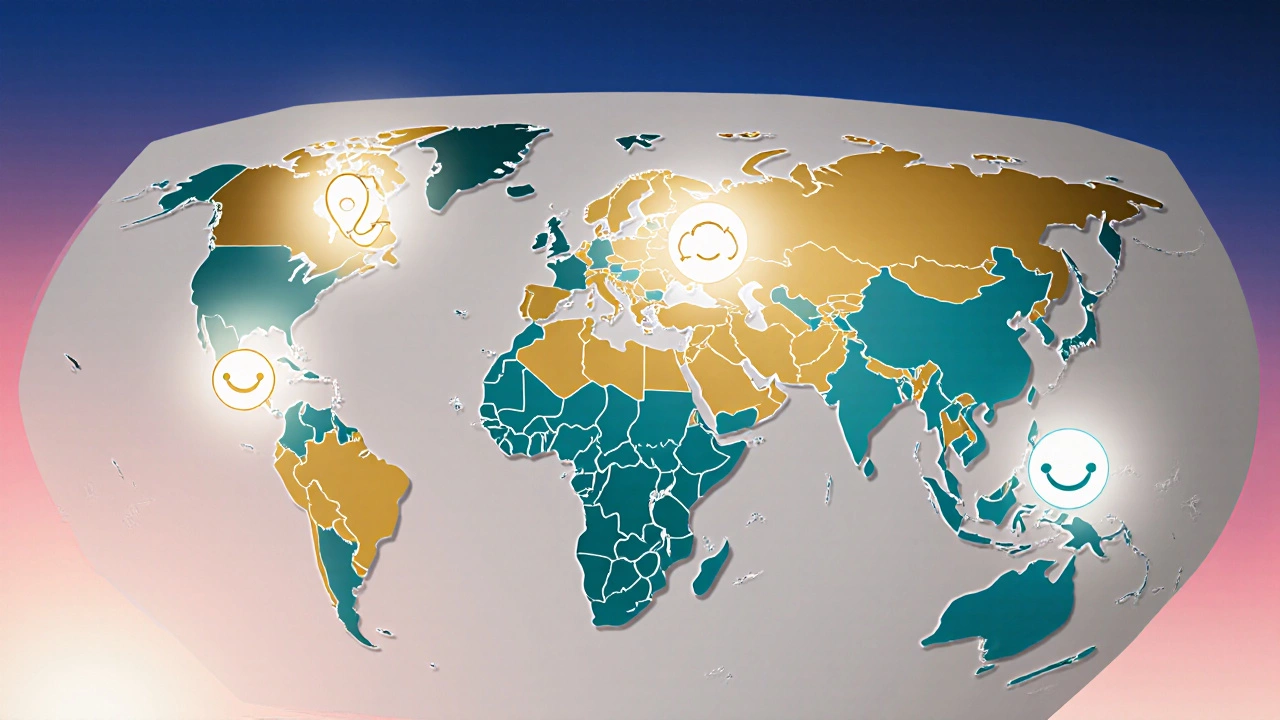Doctor Happiness Score Calculator
Personalize Your Happiness Score
Adjust the importance of salary, work hours, and health system quality to see how they impact happiness scores.
Your Personalized Happiness Scores
| Country | Salary Score | Work Hours Score | Health System Score | Overall Score |
|---|
Ever wondered which corner of the world lets doctors actually enjoy their work and life? Recent global surveys show a clear pattern: a handful of nations consistently rank at the top of the doctor happiness leaderboard. Knowing where the happiest doctors live helps aspiring physicians, recruiters, and medical tourists make smarter decisions about where to train, work, or seek care.
What the Data Says: The Physician Happiness Index
Physician Happiness Index is a composite score that blends job satisfaction surveys, average remuneration, work‑hour averages, and health‑system quality metrics. The index is compiled annually by a coalition of the World Health Organization and the Organisation for Economic Co‑operation and Development (OECD) using data from the Medscape Physician Happiness Report and national health ministries. In 2025, the index highlighted six countries where doctors not only earn well but also report the greatest work‑life balance.
Why Doctor Happiness Matters for Medical Tourism
Happy physicians tend to provide better patient communication, lower error rates, and more innovative treatments-key factors for medical tourists seeking high‑quality care abroad. When a country's doctors are satisfied, the whole health‑system benefits: shorter wait times, more research funding, and higher overall patient satisfaction scores.
Top Six Countries for Doctor Happiness in 2025
| Country | Physician Happiness Score* (0‑100) | Average Annual Salary (USD) | Average Weekly Hours | Health‑System Rating (OECD) |
|---|---|---|---|---|
| Switzerland | 92 | 210,000 | 42 | 9.5 |
| Norway | 89 | 165,000 | 38 | 9.2 |
| Australia | 87 | 158,000 | 40 | 9.0 |
| Canada | 85 | 152,000 | 41 | 8.8 |
| Netherlands | 84 | 149,000 | 39 | 9.1 |
| Germany | 82 | 140,000 | 43 | 9.0 |
*Score combines satisfaction rating (0‑100) from the Medscape survey, salary index, and average weekly work hours.

Key Factors Behind High Physician Satisfaction
- Work‑Life Balance: Nations scoring above 8 in the OECD’s work‑hour index allow doctors to spend more time with family, hobbies, or research.
- Compensation: Competitive salaries reduce financial stress and enable better access to continuing education.
- Healthcare System Structure: Publicly funded systems with low bureaucracy free doctors from excessive paperwork.
- Professional Autonomy: Trust in clinical judgment and involvement in policy‑making boost morale.
- Continuing Education Opportunities: Robust research funding and CME programs keep physicians engaged.
How to Evaluate a Country Before Relocating
- Check the latest Medscape Physician Happiness Report for satisfaction scores specific to your specialty.
- Compare average salaries with cost‑of‑living indexes (Numbeo, Expatistan).
- Research work‑hour regulations and on‑call expectations in the target country’s medical licensing board.
- Identify language requirements and credential recognition pathways (e.g., USMLE, PLAB, AMC).
- Reach out to expat physician communities for first‑hand experiences; forums like Internationals Medical Professionals Network are valuable.
Potential Pitfalls and How to Avoid Them
Even the happiest doctors face challenges when moving abroad. Common issues include delayed licensing, cultural adjustments, and differences in patient expectations. To smooth the transition:
- Start the credentialing process at least a year ahead; many countries require a local internship or supervised practice period.
- Enroll in language immersion programs; proficiency raises both patient trust and peer integration.
- Negotiate contract clauses that guarantee a reasonable on‑call schedule during the first 12 months.
- Consider a short‑term locum stint to test the waters before committing to a permanent position.

Case Study: Dr. Maya’s Move from India to Australia
Dr. Maya, a cardiologist with ten years of experience, relocated to Sydney in 2024 after reading the 2023 Physician Happiness Report. She cited Australia’s high scores for work‑life balance and a transparent licensing pathway via the Australian Medical Council. Within six months, her weekly hours dropped from 55 to 42, and her patient satisfaction ratings rose by 18% - a direct reflection of the supportive clinical environment. Maya’s story illustrates how data‑driven relocation can lead to tangible professional and personal gains.
Quick Checklist for Aspiring Happy Doctors
- Identify top‑ranking countries (Switzerland, Norway, Australia, Canada, Netherlands).
- Gather salary, cost‑of‑living, and work‑hour data.
- Verify credential transfer requirements.
- Plan language proficiency improvement.
- Connect with local physician networks for insider tips.
Frequently Asked Questions
Which country offers the best work‑life balance for doctors?
Norway consistently ranks highest for work‑life balance, with an average of 38 weekly hours and generous parental leave policies that extend to medical staff.
How reliable is the Physician Happiness Index?
The index combines data from the WHO, OECD, and the Medscape survey, covering over 150,000 physicians worldwide, making it one of the most comprehensive measures of doctor satisfaction.
Can I practice in Switzerland if I’m trained in the US?
Yes, but you’ll need to pass the Swiss Federal Exam and fulfill a six‑month supervised practice period. Language proficiency in German, French, or Italian is also mandatory depending on the canton.
Do higher salaries always mean happier doctors?
Not always. While compensation is a key driver, excessive workload, intense bureaucracy, or limited autonomy can offset financial benefits, as seen in the United States where salaries are high but satisfaction scores lag behind.
What are the first steps to move to a happier doctor destination?
Start by researching the physician happiness rankings, then contact the national medical board for licensing requirements, and finally arrange language training and a short‑term locum position to acclimate.
